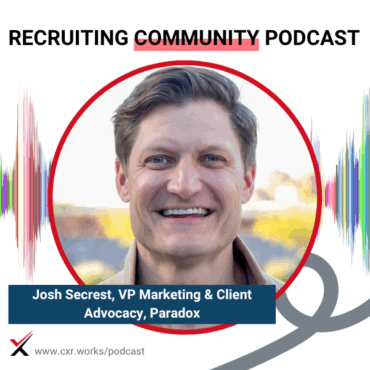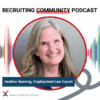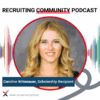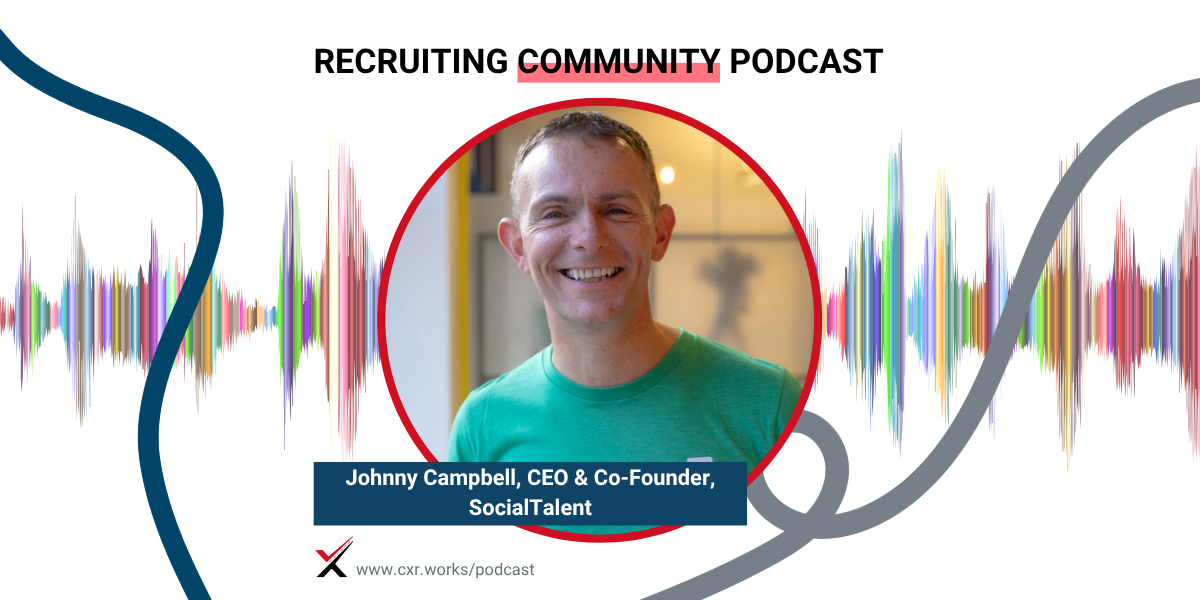
Talent Acquisition as a Revenue Driver
How do you hire 2 million people a year? Josh Secrest shares how automation and ROI-focused TA strategies helped McDonald’s scale hiring—without sacrificing quality.
 play_arrow
play_arrow
Beyond ‘Don’t Do X’: Compliance as Problem-Solving Cami Grace
 play_arrow
play_arrow
Career Crossroads: A New Series from the CXR Team Cami Grace
 play_arrow
play_arrow
Agentic AI in Talent Acquisition: What Recruiters Need to Know and Plan For Cami Grace
 play_arrow
play_arrow
Russ Mountain Memorial Scholarship Spotlight with Caroline Wittenauer Cami Grace

In this episode, we sit down with Johnny Campbell, CEO of SocialTalent, to explore the future of hiring and recruitment. Johnny shares how his company is rethinking hiring practices by empowering both recruiters and candidates with cutting-edge tools and strategies. From the importance of equitable interview preparation to leveraging AI for scalable, personalized candidate experiences, this conversation dives into the transformative potential of technology in recruitment.
We also discuss how companies can create more meaningful interactions with candidates, even at scale, and why the balance between automation and human touch is crucial for high-quality hiring. Whether you’re a recruiter, hiring manager, or HR leader, you’ll leave with actionable insights on enhancing candidate experience and staying ahead in an AI-driven world.
[3:00] – Johnny Campbell’s journey from recruiter to educator and founder of SocialTalent.
[6:45] – A lightbulb moment: How an internal hiring experience sparked a new approach to candidate training.
[10:25] – Why equitable interview preparation benefits both internal and external candidates.
[14:50] – Addressing the AI-influenced surge in applications and its impact on screening processes.
[18:10] – Creative ways companies like Siemens and Accenture are enhancing candidate experience through training.
[27:15] – Balancing automation and personalization for high-volume vs. professional hiring.
[35:40] – The future of AI in recruitment: Simulations, real-time feedback, and auditing hiring managers.
[48:20] – Why companies should focus on “quality of hiring” instead of just “quality of hire.”
If you enjoyed this episode, please take a moment to rate, follow, and review the podcast! Don’t forget to share it with your network to keep the conversation going.
Title:
Tools for Pre-Interview Candidate Training
Featured Guests:
Johnny Campbell, CEO, SocialTalent
Hosts:
Chris Hoyt, President, CareerXroads
Gerry Crispin, Co-Founder, CareerXroads
Episode Overview:
Chris Hoyt and Gerry Crispin talk with Johnny Campbell about a bold shift in hiring strategy: training not just recruiters, but also candidates. Drawing from a lightbulb moment during an internal interview, Johnny shares how SocialTalent developed tools to help candidates—internal and external—improve their interview skills and compete on a more equitable playing field. The conversation covers high-volume hiring, automation, AI’s role in resume tailoring, and the critical need to improve both recruiter and hiring manager effectiveness.
Key Topics:
Building candidate interview training to level the playing field
Equipping internal mobility candidates with the tools to succeed
AI-driven screening tools and their impact on volume hiring
Personalized rejection feedback and candidate experience
Interview simulation tools for recruiters and hiring managers
Measuring “quality of hiring” as a path to improving “quality of hire”
Future vision: AI-enabled feedback for hiring conversations
Notable Quotes:
“Everyone deserves to start from the same level playing field. Why not help all candidates communicate better in structured interviews?” — Johnny Campbell
“If you’re not skilled at interviewing, you shouldn’t be hiring.” — Johnny Campbell
“We’ve been obsessed with ‘quality of hire.’ It’s time to measure ‘quality of hiring.’” — Johnny Campbell
“Knowing what to say is one thing. Knowing how to interrupt, redirect, or probe deeper—that’s something else entirely.” — Johnny Campbell
Takeaways:
Candidate preparation is no longer just a recruiter’s responsibility—it’s a scalable opportunity. By using automation to personalize candidate feedback and simulations to train recruiters and hiring managers, organizations can dramatically improve hiring outcomes. Johnny Campbell makes the case for shifting attention to the hiring process itself as the foundation for long-term talent quality and equity.
Want more conversations like this?
Subscribe to the CXR podcast and explore how top talent leaders are shaping the future of recruiting. Learn more about the CareerXroads community at cxr.works.
Chris Hoyt: It might be the world’s reddest delay—thanks to an unexpected 45-minute Windows update. I’ve never had an update take that long! I’m so sorry, guys.
Gerry Crispin: Microsoft’s slowing down a little. It’s all the AI stuff, you know.
Chris Hoyt: Years ago, I left the Microsoft ecosystem and switched to Chrome. Never had any issues. But then about a year ago, I thought, “Seems like it’s working okay,” and came back to Windows. And now, here I am, getting hit with crazy updates again. No warning—just, boom, 45 minutes gone.
Is it the machine or is it me? We’ll never know. Is the issue between the monitor and the chair? Maybe.
Johnny Campbell: Might be. Might be.
Chris Hoyt: I’m not above it. I’ll own it—I could be the problem.
But let’s jump right in. Johnny, I’ll skip the intro bumper. I know you’ve got a tight schedule, and we’re grateful to have you here.
For those who don’t know you—though we’ve known you for quite some time—you’re a recruiter turned educator and champion of knowledge delivery. Want to give a quick elevator pitch on who Johnny Campbell is?
Johnny Campbell: Sure! I’m the guy in the green t-shirt you might see at recruiting events.
I’ve been a recruiter since I left university 27 years ago. Around 2008, during the social media boom, I started teaching folks how to use social media for recruiting—because they just weren’t doing it well.
That evolved into building a software company to scale that education: SocialTalent. Our mission is to make you better at hiring the people who make your organization better. So it’s all about hiring excellence—how to do it well and how to scale that quality. That’s my passion.
Gerry Crispin: And you do all this from right outside of…
Johnny Campbell: Dublin, Ireland. I travel a lot, though. I’ve met both of you at different conferences in the States.
Chris Hoyt: We’ve got some lag going on, so let’s dive in.
Today’s topic is candidate education, which traditionally fell to recruiters helping candidates prep for roles. But there’s a new twist: educating candidates upfront. What inspired SocialTalent to start working on tools that train candidates?
Johnny Campbell: Let me tell you a story.
A couple years ago, we were developing new content for internal mobility. There was a big push for it then—and still is. LinkedIn even showed internal mobility was up recently versus net-new hiring.
We partnered with folks like Bev Kaye to build content. But I wasn’t practicing what I preached until I was hiring internally for a role. I interviewed a long-time employee—super capable—but she totally bombed the interview. I was shocked. Then I realized: she hadn’t interviewed in eight years.
Meanwhile, external candidates who jump jobs every couple of years are pros at interviewing. They’re better at convincing someone they can do the job, even if they’re not better at actually doing it.
That was a lightbulb moment. How many people are failing interviews not because they lack skill, but because they lack interview skills?
So I gave her feedback, let her redo the interview, and she prepped using some of our content. She nailed it the second time and got the job.
I shared that story with a customer who said, “That’s great, but you can’t only offer that to internal candidates—it’s not equitable. External candidates deserve the same shot.”
And he was right. Everyone deserves to start from the same level playing field. Why not help all candidates communicate better in structured interviews? This doesn’t help people fake it—it helps good people show it.
Gerry Crispin: That’s a wonderful story—and definitely a lightbulb moment.
There’s a big difference between someone who’s great at interviewing versus someone who’s great at the job. Giving all candidates an equal footing is huge.
I remember Roche doing basic interview training for all candidates a decade ago. It was primitive, but a start. And Google had examples where they’d share real interviews (with permission) to show candidates what to expect.
So I love this idea—giving everyone a consistent foundation to build on.
Johnny Campbell: It’s even more critical now with AI in the mix. You covered this on a recent podcast—“candidate cheating,” or rather, candidate use of AI.
Accenture, for example, told us their application volume jumped by 2 million in the last 12 months. Most of those applicants looked really good—too good. Their suspicion? Many were using AI to tailor resumes and cover letters for each role.
So now, they’re adding a new screening stage before the recruiter gets involved—something that truly assesses skills.
Other organizations are doing similar things. Siemens, for instance, added a strengths assessment that provides candidates with detailed feedback. That helps screen effectively and adds value for the candidate.
Consumer brands are also giving interview training or career advice, especially when rejecting candidates. It improves candidate experience and builds long-term goodwill.
Gerry Crispin: You’re talking about upskilling both recruiters and candidates, and automating more to engage more people meaningfully. That’s a win-win.
Johnny Campbell: Exactly. Solving both the assessment challenge and the candidate experience issue.
Chris Hoyt: [Lag delay]…
Johnny Campbell: Looks like Chris is frozen on us again, but he’s there.
Gerry Crispin: This top-of-funnel challenge is growing. We’re seeing more applications than ever, and it’s impossible to screen effectively without automation. AI-generated resumes are making it harder to tell who’s really qualified.
Giving feedback helps—and makes candidates feel like they’re competing, not just expressing interest. If we can build tools that help candidates engage meaningfully, we’re in a much better place.
Johnny Campbell: I love that. In high-volume hiring, full automation works well. Think fast food or retail—candidates are happy with a fully digital process. In professional hiring, though, it’s more like a Michelin-star experience. You want personalization, but also efficiency where it makes sense—like scheduling or application steps.
If we automate the right parts, we free up resources to add value where it matters—like giving personalized training, career advice, and rejection feedback.
For example, at HMRC in the UK, they built a $30/month tool that screens 60,000 applicants a year. It automatically rejects the bottom 60% with personalized reasons based on job requirements. No recruiter could do that manually—but AI can.
Gerry Crispin: That level of analytics is critical. And I agree—we need to go beyond just evaluating who’s ready now. We need to identify who could be ready six months or a year from now.
Johnny Campbell: BCG does that really well. They build long-term relationships with undergrads—sometimes engaging them and their families a year or more before they’re hired. It’s white-glove.
Of course, most companies can’t do that. But if you automate some parts of your process, it frees you up to build those longer-term pipelines.
A friend of mine runs a Microsoft training site in Eastern Europe. People sign up for free courses—and it doubles as a recruiting pipeline. They’re learning Microsoft skills and quietly entering the hiring radar. Brilliant.
Gerry Crispin: If SocialTalent can upskill recruiters like that, you’re not just serving today’s needs—you’re building the next generation of talent.
Johnny Campbell: That’s the goal.
We just launched simulations that help you apply what you’ve learned. Knowledge only becomes skill with practice, right? So now, recruiters can simulate interviews with virtual candidates and get real-time feedback.
Same with sourcing. Glenn Cathy’s Boolean search training now includes feedback tools that evaluate your strings and help you improve.
We can scale this to a million people—all personalized.
Gerry Crispin: You know the simulation I want? Practicing conversations with hiring managers as equals. That’s the one skill many recruiters lack—bringing data, insight, and confidence into that relationship.
Johnny Campbell: You’ll be glad to hear we launched 116 simulations last week—including several focused on tough hiring manager conversations. They’re deliberately difficult—dismissive, skeptical hiring managers that you have to win over.
Gerry Crispin: That’s the one I want to try.
The rest you can coach or automate. But that skill—being a true talent advisor—is make or break.
Johnny Campbell: Totally agree. And in the future, we’ll have AI assistants listening in on hiring manager calls and interviews—providing real-time feedback. But it still comes down to human nuance.
Knowing what to say is one thing. Knowing how to interrupt, redirect, or probe deeper—that’s something else entirely. You need practice to build those instincts.
Gerry Crispin: 80% of the process can be automated. The last 20%? That’s where mastery matters.
There will be fewer recruiters doing interviews—but they’ll be much better at it.
Johnny Campbell: And the same goes for hiring managers. Those who aren’t skilled at interviewing shouldn’t be hiring. But how do you train 20,000 managers? That’s the next big challenge.
Gerry Crispin: Companies don’t audit their hiring managers—even after training. AI could do that. It could provide transparency, improve consistency, and flag poor practices.
Johnny Campbell: Exactly. We’ve been obsessed with “quality of hire” for decades. I think it’s time to measure quality of hiring—the process itself. That’s where real improvement lies.
Gerry Crispin: And if we get that right, we’ll finally be able to define and measure quality of hire in a meaningful way.
Johnny Campbell: Couldn’t agree more. Always a pleasure, Jerry.
Announcer: Thanks for listening to the CXR channel. Please subscribe on your favorite podcast platform and leave us a review. Learn more at cxr.works or follow us on social @careerxroads. Catch you next time.
Tagged as: Podcast, Candidate, Employer Branding, Interview, Talent Acquisition, Candidate Experience, quality of hire, AI, SocialTalent.
Chris Hoyt is the President of CareerXroads, a global peer community for talent acquisition leaders driving strategic change. With decades of experience leading recruiting innovation at Fortune 500 companies, Chris now advises enterprise TA teams on tech, process, and leadership. He’s a frequent speaker at conferences like SHRM, HR Tech, LinkedIn, and UNLEASH, and he’s known for pushing conversations beyond buzzwords to get to what really works in hiring. Through CXR, he connects top TA professionals to solve real problems, challenge norms, and shape the future of recruiting.

How do you hire 2 million people a year? Josh Secrest shares how automation and ROI-focused TA strategies helped McDonald’s scale hiring—without sacrificing quality.

